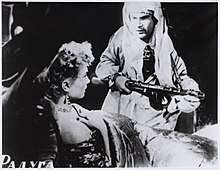Rainbow (1944 film)
Rainbow (Ukrainian: Веселка; translit. Veselka, Russian: Радуга; translit. Raduga), is a 1944 Soviet war film directed by Mark Donskoy and written by Wanda Wasilewska based on her novel,[1] Tecza. The film depicts life in a German-occupied village in Ukraine from the viewpoint of the terrorized villagers.
| Rainbow | |
|---|---|
.jpg) | |
| Directed by | Mark Donskoy |
| Produced by | Kievskaya Kinostudiya |
| Written by | Wanda Wasilewska |
| Starring | Nina Alisova Natalya Uzhviy Vera Ivashova Yelena Tyapkina Hans Klering |
| Music by | Lev Schwartz |
| Cinematography | Boris Monastyrsky |
Production company | |
| Distributed by | Artkino |
Release date |
|
Running time | 93 minutes |
| Country | Soviet Union |
| Language | Russian |
Cast
- Natalya Uzhviy as Olena Kostyuk (as N. Uzhviy)
- Nina Alisova as Pusya (as N. Alisova)
- Elena Tyapkina as Feodosya (as E. Tyapkina)
- Valentina Ivashova as Olga (as V. Ivasheva)
- Anton Dunaysky as Grandfather Okhabko (as A. Dunayskiy)
- Anna Lisyanskaya as Malyuchikha (as A. Lisyanskaya)
- Hans Klering as Captain Kurt Werner (as G. Klering)
- Nikolai Bratersky as Gaplik (as N. Braterskiy)
- Vladimir Chobur as Lt. Kravchenko (as V. Chobur)
- Viktor Vinogradov as Mishka, Malyuchikha's child (as Vitya Vinogradov)
Plot

The German conquerors are above nothing, not even the slaughter of small children,[1] to break the spirit of their Soviet captives. Suffering more than most is Olga (Nataliya Uzhviy), a Soviet partisan who returns to the village to bear her child, only to endure the cruelest of arbitrary tortures at the hands of the Nazis.[2] Eventually, the villagers rise up against their oppressors-but unexpectedly do not wipe them out, electing instead to force the surviving Nazis to stand trial for their atrocities in a postwar "people's court." (It is also implied that those who collaborated with the Germans will be dealt with in the same way).[3]
Reception
"Brilliantly acted by virtually everyone in the cast, Rainbow is a remarkable achievement, one that deserves to be better known outside of Russia."[3] It has been described as the most powerful and effective of the Soviet propaganda films produced during the war.[2] The film was recommended to President Franklin Roosevelt by the American ambassador in Moscow in early 1944. Roosevelt cabled Ambassador W. Averell Harriman in Moscow on March 14, 1944 with the message that he had viewed the film, and found it so "beautifully and dramatically presented that it required little translation." FDR stated that he hoped it could be shown to the American public.
References
- Stites, Richard (1992). Russian popular culture: entertainment and society since 1900. Cambridge University Press. p. 114. ISBN 978-0-521-36986-2.
- Short, Kenneth R. M. (1983). Film & radio propaganda in World War II. Taylor & Francis. p. 116. ISBN 978-0-7099-2349-7.
- "Raduga (1944) - Mark Donskoy - Synopsis, Characteristics, Moods, Themes and Related - AllMovie". AllMovie.